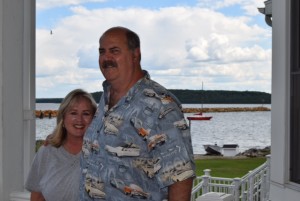By Susan Bromley
Special to The Citizen
Judi and Dave Pearce have quite the magnificent—and unique— view from their front porch, no matter which way they turn as they sit in their white wicker glider.
Look to the right and Lake Huron shimmers in the sunlight as freighters, sailboats and cruise ships pass by.
Look to the left and antique carriages drawn by horses and bicyclists pedal down streets bracketed by antique lampposts from which baskets are hung with a profusion of burgeoning, colorful flowers.
The Pearces are among about 500 people who reside on Mackinac Island and the couple, who also have an Atlas Township home, recently shared what it is like to live a “charmed island life” for the past decade.
“It’s lovely,” is a common refrain from Judi as she speaks about all that she has experienced in the 10 years since they purchased their 3-story condominium, one of four that comprise a single building resembling a Victorian home, located on the water side of Main Street, between Mission Point and St. Anne’s Church.
Locals refer to her home as “Mackinac Place,” and she notes that despite the advent of GPS and assignment of numerical addresses, no one who lives on the island recognizes a location by number, just by names, including “the Doll House,” “Bonnie Doon,” “Brigadoon” or “Jacob Wendell.”
The island, which is nearly 3.8 square miles in area with 8 miles of coastline, is rich in history, settled by Native Americans in the 17th century, used as a strategic military location by the British during the American Revolutionary War, and the site of two battles during the War of 1812.
Architecture is varied, but with styles that are in keeping with those from the 1930s or earlier, no matter how recent the build, including the Pearces’ home, which was constructed in 2005, and which they saw for sale while biking around the island shortly after they married in 2006. Each of them had a home to sell downstate and on every visit to Mackinac, they didn’t want to leave. When they saw a man sitting on the porch, who they later learned was not only the realtor, but had also built the condos, he offered to let them take a look around inside at the 4-bedroom home. After they left Mackinac, the realtor sent them pictures every day— of the claw-footed cast-iron tub in the condo, of hydrangeas the size of cantaloupes on the island.
The couple soon returned, trying to make a decision on whether to make the purchase while Judi lamented the absence of their attorney to advise on whether the condo was a fair price and Dave suggested they go home and call their lawyer. As it was a Sunday, they decided to go to St. Anne Church on the island, and in a stroke of amazing coincidence, or fate, found their attorney sitting in the front pew. After church, he agreed to come over and look at the condo to counsel them on the purchase.
“He had one piece of advice,” said Judi. “He said, ‘Do it, you will add 10 years to your life.’”
They followed the advice and although some medical issues prompted their early retirements, Dave, a former Chrysler and Toyota manager, and Judi, a former marketing support services provider for Ross Roy in Detroit, are now enjoying living a dream on Mackinac.
“The whole island is our playground,” said Judi. “We like it equally in the winter as in the summer.”
They are not as enamored of the fudge as some of the 15,000 visitors the island sees daily during the high tourist season and Judi laughs when friends ask how they can stand “the smell” from the manure of some 600 horses who live on the island during the summer, sources of old-fashioned transportation where automobiles are forbidden other than emergency vehicles.
“Our answer is, ‘What smell?’” she said. “We’re used to it, and to us, it’s a naturalized smell. They clean streets thoroughly with an antique street washer and park employees pick up the streets. I’d rather smell (horse manure) than exhaust or pollution. Our island is so clean, the air is clean, and the water is delicious that comes out of the tap. It’s really a charmed life. Just lovely.”
Another question they are often asked is how they “can stand” living in a place where the common perception is that it is difficult to buy the necessities of life, or things that add to the enjoyment of life. They do buy their non-perishable items on the mainland and bring them over on the ferry like other islanders so they can avoid paying $5 for a roll of toilet paper, but they love the island grocer, Andy Doud, whose market carries fresh, high quality produce and meat. Even though these staples cost a little more, it’s a small price to pay to support the man who supplies everything they need to cook with and even delivered pizza to them on a cold winter night when he had a broken arm because the Pearces don’t have a snowmobile.
(Check back next week for part 2)
